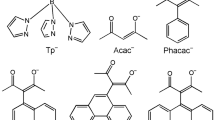A study was carried out on the effect of a heavy chlorine atom introduced into the aromatic fragment of a 1,3-diketone ligand in Eu3+ coordination compounds on the spectral and luminescent properties of complex compounds. The data obtained from the absorption, optical excitation, fluorescence, and phosphorescence spectra as well as from the kinetics of the luminescence intensity permit estimation of the efficiency of energy transfer processes within the compounds studied. Introduction of a heavy chlorine atom was found to raise the energy of the first excited singlet state from 24,500 to 26,000 cm–1 but not affect the energy of the triplet level of the ligand. Furthermore, introduction of a chlorine atom leads to a decrease in the nonradiative relaxation constant (from 1290 to 840 s–1) and thereby triples the luminescence quantum yield from 23 to 64%. Hence, a new approach for the rational construction of useful coordination compounds of Eu3+ ions with 1,3-diketone ligands has been developed consisting of the substitution of a hydrogen atom by a heavy chlorine atom in the aromatic fragment of the ligand.
Similar content being viewed by others
References
D. A. Kordeyro-Magrino, V. M. Korshunov, K. A. Lyssenko, V. E. Gontcharenko, Yu. A. Belousov, C. Pettinari, and I. V. Taydakov, Inorg. Chim. Acta, 510, Article ID 119764 (2020).
J.C. G. Buenzli, Coord. Chem. Rev., 293, 19–47 (2015).
K. Binnemans, Coord. Chem. Rev., 295, 1–45 (2015).
S. I. Weissman, J. Chem. Phys., 10, No. 4, 214–217 (1942).
V. M. Korshunov, A. V. Tsorieva, V. E. Gontcharenko, S. R. Zanizdra, M. T. Metlin, T. A. Polikovskiy, and I. V. Taydakov, Inorganics, 11, No. 1, 15 (1023).
F.-F. Chen, Z.-Q. Chen, Z.-Q. Bian, and C.-H. Huang, Coord. Chem. Rev., 254, Nos. 9–10, 991–1010 (2010).
A. R. Willauer, I. Douair, A.-S. Chauvin, F. Fadaei-Tirani, J.-C. G. Bünzli, L. Maron, and M. Mazzanti, Chem. Sci., 13, No. 3, 681–691 (2022).
F. Marchetti, R. Pettinari, and C. Pettinari, Coord. Chem. Rev., 303, 1–31 (2015).
F. Marchetti, C. Pettinari, A. Di Nicola, A. Tombesi, and R. Pettinari, Coord. Chem. Rev., 401, Article ID 213069 (2019).
E. A. Varaksina, M. A. Kiskin, K. A. Lyssenko, L. N. Puntus, V. M. Korshunov, G. S. Silva, R. O. Freire, and I. V. Taydakov, Phys. Chem. Chem. Phys., 23, No. 45, 25748–25760 (2021).
H. Xu, L.-H. Wang, X.-H. Zhu, K. Yin, G. Y. Zhang, X.-Y. Hou, and W. Huang, J. Phys. Chem. B, 110, 3023–3029 (2006).
K. Binnemans, Handbook on the Physics and Chemistry of Rare Earths, Katholicke Universiteit Leuven, Department of Chemistry 200F, B3001 Leuven, Belgium, Elsevier (2005), pp. 107–272.
M. Latva, M. Takalo, V.-M. Makkala, C. Matachescu, J. C. Rodriguez-Ubis, and J. Kankare, J. Lumin., 75, No. 2, 149–169 (1997).
L. V. Taydakov, B. E. Zaitsev, S. S. Krasnoselskiy, and Z. A. Starikova, J. Rare Earths, 29, 719–722 (2011).
D. Singh, S. Bhagwan, A. Dalal, K. Nehra, R. Kumar Salni, K. Singh, S. Kumar, and L. Singh, J. Lumin., 223, Article ID 117255 (2020).
E. A. Varaksina, I. V. Taydakov, S. A. Amrozevich, A. S. Selyukov, K. A. Lyssenko, L. T. Jesus, and R. O. Freire, J. Lumin., 196, 161–168 (2018).
M. T. Metlin, D. O. Goryachil, D. F. Aminev, N. P. Datskevich, V. M. Korshunov, D. A. Metlina, A. A. Pavlov, I. V. Mikhalchenko, M. A. Kiskin, V. V. Garaeva, and I. V. Taydakov, Dyes Pigments, 195, Article ID 109701 (2021).
V. V. Sivchik, A. I. Solomatina, Y.-T. Chen, A. J. Karttunen, S. P. Tunik, P. T. Chou, and I. O. Koshevoy, Angew. Chemie, 127, No. 47, 14261–14266 (2 015).
W. Franek, Monatshefte für Chemie/Chemical Monthly, 127, 895–907 (1996).
P. Hänninen and H. Härmä, Lanthanide Luminescence: Photophysical, Analytical and Biological Aspects, University of Turku, Department of Cell Biology and Anatomy, 20520 Turku, Finland, Springer-Verlag, Berlin–Heidelberg (2011), pp. 264–273.
H.-F. Li, G.-M. Li, P. Chen, W.-B. Sun, and P.-F. Yan, Spectrochim. Acta A: Mol. Biol. Spectr., 97, 197–201 (2012).
J. C. G. Bünzli, Eur. J. Inorg. Chem., 44, 5058–5063 (2017).
L. N. Puntus, A.S. Chauvin, and J.-C. G. Bünzli, Eur. J. Inorg. Chem., 16, 2315–2326 (2017).
A. Beeby, L. M. Clarkson, R. S. Dickins, S. Faulkner, D. Parker, L. Royle, A. S. de Sousa, J. A. Gareth Williams, and M. Woods, J. Chem. Soc., Perkin Trans., 2, 493–503 (1999).
M. P. Oude Wolbers, F. C. J. M. van Veggel, B. H. M. Snellink-Rul, J. W. Hofstraat, F. A. J. Geurts, and D. N. Reinhoudt, J. Am. Chem. Soc., 119, No. 1, 138–144 (1997).
K. M. F. Shahil and A. A. Balandin, Nano Lett., 2, 861–867 (2012).
M. Kasperczyk, S. Person, D. Ananias, L. D. Carlos, and L. Novotny, Phys. Rev. Lett., 114, Article ID 163190 (2015).
Author information
Authors and Affiliations
Corresponding author
Additional information
Translated from Zhurnal Prikladnoi Spektroskopii, Vol. 90, No. 2, pp. 230–238, March–April, 2023. https://doi.org/10.47612/05147506-2023902230238.
Rights and permissions
Springer Nature or its licensor (e.g. a society or other partner) holds exclusive rights to this article under a publishing agreement with the author(s) or other rightsholder(s); author self-archiving of the accepted manuscript version of this article is solely governed by the terms of such publishing agreement and applicable law.
About this article
Cite this article
Tsorieva, A.V., Polikovskiy, T.A., Metlin, M.T. et al. Effect of the Introduction of a Chlorine Atom into the Aromatic Fragment of the 1,3-Diketone Ligand on the Luminescence Efficiency of Novel Eu3+ Ion Coordination Compounds. J Appl Spectrosc 90, 325–333 (2023). https://doi.org/10.1007/s10812-023-01539-1
Received:
Published:
Issue Date:
DOI: https://doi.org/10.1007/s10812-023-01539-1



